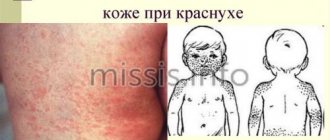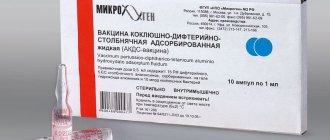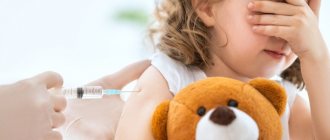Measles, rubella, and mumps are infectious diseases that pose a danger to human health. They can lead to damage to the central nervous system, encephalitis, meningitis, hearing loss, and blindness. If a pregnant woman gets rubella, the child is often born with deformities and pathologies. Mumps during pregnancy provokes miscarriage in 25% of women.
A comprehensive vaccination against rubella, measles and mumps (one vaccine against three infections at once) allows you to introduce an immunobiological drug into the child’s body. It will prevent future infection with these infections, which means it will protect the baby from real danger. Therefore, it is so important for parents to know as much detailed information as possible about this vaccination.
At what age
It is very important not to miss vaccination so that it is carried out in accordance with the vaccination schedule against these infectious diseases. Doctors should educate parents in advance when giving vaccinations against rubella, measles and mumps. The vaccine is administered three times: in infancy, on the eve of school and during adolescence. Repeated administration of the drug is called revaccination. A typical vaccination schedule for rubella, measles and mumps is as follows:
Repeated administration of the drug is explained by the fact that not all children develop immunity to these infections after the first vaccination. In addition, in this case there is such a thing as expiration date. Time passes, and artificially acquired immunity tends to weaken. Therefore, parents are advised to know exactly how long the vaccine against rubella, mumps and measles lasts by checking this calendar so as not to miss the next one. In adolescence, revaccination is necessary for several reasons:
- Extension of protection for girls who, over the next few (5-10) years, will give birth to children for whom rubella and mumps viruses are dangerous during intrauterine development.
- Immunity against measles is successfully activated when encountering the vaccine virus.
- Extension of protection for young men for whom mumps is extremely undesirable at this age (one of the complications of this disease specifically for men is infertility).
If a child for some reason has not been vaccinated, he is vaccinated at 13 years of age. On average, the validity of vaccinations against mumps, measles and rubella is about 10 years: this is the frequency with which the population is vaccinated. However, during outbreaks of infection, vaccinations are given unscheduled, which makes it possible to extinguish outbreaks of disease.
INDICATIONS FOR USE
Prevention of rubella in accordance with the National Preventive Vaccination Calendar, vaccination is carried out at the age of 12 months, revaccination at 6 years.
The national calendar of preventive vaccinations also provides for vaccination of children aged 1 to 18 years, who have not been sick, not vaccinated or vaccinated once against rubella, as well as girls aged 18 to 25 years, who have not been sick and have not been vaccinated before
Vaccinations can also be administered to other groups of the population to prevent outbreaks of rubella in limited populations or for epidemiological indications
Place of vaccination
Since the first vaccination is given to a very small baby, parents are worried about where to get the rubella vaccine for their baby. Here are the medical rules:
- at 12 months the drug is injected into the thigh, namely into its outer surface;
- in other cases - into the shoulder muscle.
The choice of these particular sites for grafting is not accidental: the skin here is thin, the muscles are close to its surface, and there is no subcutaneous fat at all. If the vaccine gets into the fat layer, it will lose its beneficial, healing properties. It is not done in the buttocks, since in this place the muscles are deep, the fat layer under the skin is thick, and there is a risk of touching the sensitive sciatic nerve.
Contraindications
Unfortunately, not all children may be vaccinated with this vaccine. There are a number of contraindications due to which these vaccinations can, unfortunately, be postponed indefinitely, or may be prohibited for life. Temporary contraindications for vaccination include:
- acute course of illness (you can get vaccinated immediately after recovery);
- pregnancy (vaccination is carried out immediately after childbirth);
- simultaneous administration of blood products (vaccination is done only after a month).
There are also permanent contraindications, which include:
- allergic reaction to certain medications (neomycin, gentamicin, kanamycin);
- allergy to egg white;
- neoplasms;
- complications after receiving the vaccine for the last time.
In these cases, vaccination is not carried out at all, so as not to worsen the child’s condition with complications.
Consequences and contraindications
The consequences of rubella vaccinations are not complications - this is a normal reaction of the body, indicating the formation of an immune response. In most cases, a person does not notice any changes, in others the following symptoms may occur:
- mild one-day illness;
- elevated temperature;
- mild rash;
- mild cramps;
- enlargement of the posterior cervical lymph nodes for no more than 2-3 days.
Vaccination is carried out with a live rubella vaccine, since the inactivated one has not shown effectiveness. In this regard, there are several contraindications to the use of the vaccine, which are divided into permanent and temporary.
Permanent contraindications:
- severe reactions and complications during the first vaccination;
- immunodeficiency, leukemia, lymphoma, malignant diseases accompanied by a decrease in cellular immunity;
- allergy to excipients included in the vaccine.
Temporary contraindications include acute diseases, exacerbations of chronic diseases, acute respiratory viral infections, and intestinal infections. A pregnant woman is also not given the vaccine. Doctors recommend that women wait to become pregnant for 3 months after vaccination. Breastfeeding is not a contraindication to vaccination.
Complications
Complications after vaccination against measles, rubella, mumps are rare, but do occur. Among them:
- allergic reactions - anaphylactic shock, urticaria, severe swelling at the injection site;
- encephalitis;
- serous aseptic meningitis;
- decrease (temporary) of platelets in the blood;
- pneumonia;
- abdominal pain;
- glomerulonephritis;
- toxic shock syndrome.
In such severe cases, it is necessary to urgently seek help from doctors. After a thorough medical examination, contraindications for further vaccination of the child will most likely be identified. However, not only complications can a small organism react to vaccination. The consequences involve a number of side effects.
Reaction to vaccination (consequences)
Usually, side effects after vaccination (measles, rubella, and mumps) frighten parents very much, although doctors immediately warn about them and notify that this is a normal reaction of a small organism. This means that the child’s immunity is actively working. This is not a pathology, no treatment is necessary, and in this case it makes no sense to refuse this vaccination in the future. These side effects include:
- after vaccination against rubella, a small rash appears on the body;
- runny nose;
- temperature increase;
- joint pain;
- cough;
- discomfort at the injection site.
These side effects should appear from 5 to 15 days after administration of the vaccine. If symptoms do not fall within the specified period after immunization, they are not related to it.
Consequences of vaccination
In general, rubella vaccination itself is infrequent. It is combined with other vaccinations. Measles and mumps medications are often given at the same time. Sometimes two injections are given: rubella serum and separately - measles and mumps. In this case, the injections should be given to different arms or legs.
But it is easier to tolerate a three-component vaccine (rubella, measles and mumps). The reaction to it will not differ from what happens after setting up a one-component composition. And psychologically it is easier for a child to endure one injection than three. The consequences of immunization against rubella in children and adults are different. So, if adults feel almost no changes in their well-being, then children may experience:
- hyperthermia, in some up to 40°C;
- cough, runny nose;
- swelling of the lymph nodes;
- nausea, diarrhea (disposable);
- dizziness with headache;
- sore throat;
- rashes on certain parts of the body.
These manifestations are clear confirmation that the body has begun to produce antibodies. Therefore, there is no need to worry too much. Except that if your body temperature is high (above 38.5°C), you should reduce it.
A reaction to the vaccine, if it occurs, appears within a few days (usually 5-15). All this time it is necessary to monitor the general condition of the child. Symptoms that appear are not always associated with vaccination. You can often catch the virus even during vaccination in a clinic where there are a lot of people, or on public transport when returning home. The infection easily attaches to a weakened body.
How long does the vaccine work?
Everyone's immune system reacts differently to the rubella virus. Therefore, the answer to the question of how long the rubella vaccine lasts cannot be unambiguous. After immunization, someone can receive lifelong protection from infection, another - only for 5 years, and it happens that it does not work at all. On average, vaccines guarantee immune protection for 10-20 years. In this regard, WHO recommends vaccination once every decade.
There is also the question of how many vaccinations need to be done to be sure that antibodies have been developed. Everything here is also individual. In general, the vaccine is administered three times a day until adulthood. How many vaccinations to give next is everyone’s business. They find out whether immunity is still active or not by a blood test for the presence of antibodies against rubella. It is clear that if they are not available, you need to get vaccinated.
Rubella vaccination and pregnancy
During pregnancy, all infections pose a threat to pregnancy. The rubella virus is considered especially dangerous for an unborn child. It penetrates through the placenta to the baby, affects him, leads to death, causes pathologies and deformities. Therefore, vaccination against rubella before pregnancy should be done in advance in order to protect the unconceived child and yourself. During the period of bearing the baby, this will no longer be possible: only after childbirth. It’s good when parents think about this even when planning a pregnancy: vaccination in this case is as successful as possible. The expectant mother’s immunity is strengthened, and the baby is no longer in danger. Moreover, pregnancy after rubella vaccination proceeds calmly, without complications or pathologies.
Vaccines
There are several types of vaccination against measles, rubella and mumps. They depend on the type of viruses included in the vaccine. All of them are of high quality, safe, effective and interchangeable. In addition, there are:
- three-component vaccine - a preparation containing three types of viruses;
- dicomponent - a combined vaccine against any two diseases;
- monocomponent - a vaccine against only one infection.
Depending on the country of origin, domestic and imported drugs are distinguished.
- Domestic
- advantage: prepared on the basis of Japanese quail eggs;
- disadvantage: there are no three-component drugs, so the injection has to be done twice.
- Imported
- advantage: easy to use, as it is three-component;
- disadvantage: not always accessible to the common man;
- brands: MMR-II (America, Holland), Priorix (Belgium); "Ervevax" (England).
A comprehensive triple vaccination of measles, rubella, mumps was created to protect against infections that are potentially dangerous for children and adults.
source: www.vse-pro-detey.ru
March 27, 2017
Vaccinations and injections
Rubella is a common viral infection that is transmitted only from person to person. The disease leads to the development of a skin rash, damage to the lymph nodes, and general intoxication. The infection is usually easily tolerated. However, the disease can threaten the life and health of the unborn child if a pregnant woman is infected. The only effective method of protection against a viral disease is the rubella vaccine.
Sign up for vaccination at the NEARMEDIC clinic
The NEARMEDIC clinic provides scheduled and unscheduled vaccinations for people of any age. Patients who do not have information about vaccinations undergo a special set of tests. A vaccination calendar is developed for infants, taking into account individual characteristics and the presence of contraindications.
The rubella vaccine is given to children and adults, especially women planning pregnancy. The patient can undergo this procedure as part of a program to prepare for pregnancy or separately by making an appointment at our clinic. According to the results of research in 2016, the NEARMEDIC clinic was included in the top ten most recommended private clinics in Moscow in a number of aspects - technical equipment, completeness of services provided, quality of staff and service.
By choosing rubella vaccination at our clinic, you receive the following benefits:
- Pre-vaccination examination. Among its tasks are the identification of contraindications, current inflammatory or chronic disease, sensitization to the auxiliary components of the vaccine (allergens of cow gelatin, yeast and egg ovalbumin). Patients undergo blood and urine tests, and according to their indications, additional studies are prescribed if necessary.
- High-quality domestic and foreign vaccines. The clinic's management monitors trends in the pharmaceutical market and selects the most advanced and effective vaccines. Today we use the Belgian vaccine against rubella, measles and mumps Priorix. This is a highly purified immunobiological preparation, including weakened strains. It is highly immunogenic and forms stable immunity, while the number of post-vaccination reactions is reduced.
- High professionalism of the staff - correct administration of the vaccine, elimination of subcutaneous administration and the formation of a lump, a special approach to a child who is afraid of injections.
If contraindications are identified, NEARMEDIC specialists postpone vaccination to a later date. This requires the development of an individual vaccination schedule, especially for an infant. To sign up for vaccination, use the form on the website or call us. You can ask all your questions by phone.
Vaccination strategies
After infection, adults and children become a source of pathogenic viral particles for 14 days before the onset of symptoms and 21 days after. In this case, the release of the rubella virus is noted in urine and feces. However, newborns with congenital rubella are especially dangerous. In such cases, the virus remains in the child’s body for up to 12 months, during which children are able to infect others.
Important! Universal vaccination against rubella of the population will completely eliminate the viral infection from the list of diseases that can affect humans. This method made it possible to defeat a deadly disease - smallpox.
Therefore, the World Health Organization (WHO) staff developed 3 effective strategies. They are aimed at reducing the risk of developing congenital rubella syndrome and the circulation of viral particles in the human population. The following tactics are distinguished:
- Vaccination against rubella in adolescent girls and patients of reproductive age. This allows you to form stable protection against viral infection and completely prevent the development of a dangerous syndrome in newborns.
- Vaccinations against rubella are carried out in children under 1 year of age, adolescents, and people of reproductive age (up to 40 years). To completely eliminate the infection, universal immunization of the population will be required within 15-20 years.
- Vaccination against rubella in childhood and adolescence (12 months, 6-7 years, 14-15 years). This tactic is aimed at eliminating the circulation of the virus within 20-30 years.
Vaccination against rubella
German measles, known for many centuries, suddenly came into the spotlight in the middle of the last century. In 1965, the epidemic broke out throughout Europe, reaching the United States by 1964. Millions of people have been ill, including adults, with subsequent complications. The consequences of this pandemic have attracted the attention of scientists to the problem of rubella infection. In America alone, in two years, 20 thousand babies were born with congenital deformities caused by maternal illness. By 1965, it became clear that vaccination against rubella was the primary task of scientists.
In the same year, doctors managed to obtain several weakened strains of rubella virus in the laboratory. The clinical trial lasted almost three years and by 1970 the vaccine finally went into commercial use. In 1971, a vaccine based on a strain isolated from human cells was licensed in Europe. It is designated RA 27/3 and is still in use today. Over time, it was licensed in the United States and several other countries. The mass immunization scheme in Europe, the UK and the States has shown a gradual decline in CRS cases and the disease in general. In 2015, the Region of the Americas was declared completely free of endemic rubella.
Today, out of 194 countries, 152 states have adopted a rubella vaccination plan. However, within each country the percentage of diseases varies, as do the cases of CRS. The WHO Strategic Advisory Group notes that the burden of rubella cannot be completely eliminated due to insufficient vaccine distribution and individual refusal to inject. In Russia in 2021, from January to June, only 3 cases of rubella were registered (according to ROSPOTREBNADZOR “Information on infectious and parasitic diseases”).
Types of vaccine preparations
The rubella vaccine is based on weakened viral particles. After injection, the pathogen enters the bloodstream, causing the development of erased symptoms of infection. Vaccination also triggers the body’s immune response to foreign bodies. As a result, antibodies against rubella are actively produced.
Important! Vaccination prevents the occurrence of an infectious process when the rubella pathogen enters the body of vaccinated people.
Rubella vaccination is done using the following vaccine agents:
- Combined (Belgian Priorix, American MMR). The drugs include several types of weakened viruses. This allows the patient to develop immunity against several infections at once. Vaccines against measles, rubella and mumps are widely used to create immunity in children and women planning pregnancy. The disadvantage is that it is highly reactogenic, so vaccination often provokes the development of adverse reactions;
- Single-component: Ervevax (England), Rudivax (France), Live rubella vaccine (Russia). The drug is created on the basis of only weakened live rubella viral particles. The vaccine is easily tolerated and rarely causes side effects. The monovalent rubella vaccine is used mainly in adults for emergency vaccination.
Many parents try to vaccinate their children separately against rubella, measles and mumps, justifying their choice by the low risk of side effects. But this opinion is wrong. In such situations, the load on the immune system only increases, because every time a vaccine is administered, the body experiences stress. Therefore, in highly developed countries, combination preparations for immunization are widely used.
DESCRIPTION OF THE MEDICINE
Cultured live attenuated rubella vaccine, lyophilisate for the preparation of solution for subcutaneous administration, made from “Live attenuated rubella vaccine, substance - frozen solution” (strain RA 27/3) produced by the Institute of Immunology, Inc., Republic of Croatia, (“INSTITUT OF IMMUNOLOGY, INC", CROATIA), registered in the Russian Federation.
Appearance: A homogeneous porous mass of white or light yellow color, a pinkish tint is allowed, hygroscopic. Pharmacotherapeutic group: MIBP vaccine ATX code: J07BJ01
Features of vaccination
Before any immunization, every child must undergo an examination by a pediatrician. This will prevent vaccination of a sick patient. The rubella vaccine is administered intramuscularly. For children under 12 months, the injection is placed in the thigh, for patients over 6 years old - in the shoulder or under the shoulder blade. The manipulation is carried out in the treatment room of the district clinic.
Important! The rubella vaccine cannot be given into the gluteal muscle. Subcutaneous fatty tissue is well developed in this area, which will reduce the rate of absorption of the vaccine. There is also the possibility of damage to the sciatic nerve.
Vaccination against rubella should be carried out taking into account the following rules:
- Immunization should be carried out by specially trained medical personnel under aseptic conditions;
- The administration of the rubella vaccine is carried out with a disposable sterile syringe, which has a thin needle with a beveled bevel;
- Before the procedure, the nurse should carefully examine the vaccine product. If the color of the rubella vaccine has changed, the suspension should not be administered;
- The ampoule with the vaccine preparation is treated with an antiseptic and opened immediately before injection;
- The skin on the leg or arm should be treated with a sterile swab, previously soaked in an antiseptic;
- Next, the rubella vaccine is administered, and the injection site is re-treated with an antiseptic.
Quite often, parents refuse the rubella vaccine because they are afraid of developing adverse reactions after vaccination. However, this vaccine preparation is easily tolerated and causes virtually no complications. It should be borne in mind that the effectiveness of immunization reaches 95%. And compliance with the listed requirements will reduce the risk of infection of the injection site and the severity of local side effects.
Vaccines used
It is correct that vaccinations against rubella, which have been given for more than 40 years, have been mandatory since 2002. Thanks to them, it is believed that rubella is a disease of young children. Although adults can also catch the virus.
Each rubella vaccine is based on a weakened strain of the virus. And just one injection guarantees 95 percent immunity, which corresponds to natural infection. Antiviral suspensions are produced in monovalent, designed to protect against one type of virus, and combined (rubella, measles, mumps or chickenpox) versions. Both imported and Russian-made drugs are used for immunization.
Among the popular ones are the Belgian Priorix and Ervevax, and the French Rudivax. Sometimes Indian or Croatian vaccines are used. Three-component, made in the USA, rarely practiced.
Cheap, but quite effective and safe, Russian vaccines do not lag behind foreign ones. They are produced from a weakened and dried live strain of rubella. The drugs have almost no side effects and are well tolerated by children. True, they have one peculiarity - to create protection, you need to give several injections, which children do not really like. But this vaccine is suitable for adults.
List of popular drugs for rubella
Brief characteristics of some drugs:
- " Priorix " - used for children 1 and 6 years old. It is a three-component vaccine, so one vaccination forms immunity against ailments such as rubella, mumps and measles. Moreover, the vaccine is suitable even when the child has had one of these illnesses. After its introduction, protection against the incoming virus will be developed, and the previous one will become inactivated. Immunity will begin to decline after Priorix after 4-5 years;
- " Ervevax " - used for rubella. Since it has virtually no side effects, it is often used to vaccinate very young children. But they can also immunize adolescents and women planning pregnancy. Its impact will be the same for everyone. Ervevax allows it to be administered along with vaccines against polio, measles, mumps and even DTP, but on the condition that they are delivered in different places. The introduction of this vaccine allows you to maintain immunity for 15 years;
- " Rudivax " - everyone who is administered the drug develops immunity from the virus of the pathology in question within 15 days. It can be stored for 20 years. Therefore, Rudivax is one of the most productive vaccines. The consequences of its setting almost do not make themselves felt by undesirable signs.
Now parents are given the right to decide for themselves whether their child should be vaccinated or not, this also applies to rubella. Since the virus does not pose a danger, many believe that even if a child gets sick, it will not significantly affect his health.
Popular Adults should also be vaccinated according to the calendar
But you should always remember about the possibility of complications, and also that the patient can become a source of infection for others, in particular for women who are going to give birth. For this reason, expectant mothers who do not have immunity from rubella should always remember the need for vaccination.
Side effects and contraindications
Rubella vaccination is usually well tolerated and does not require targeted therapy. Side effects, if they manifest themselves in any way, go away on their own within a few days. The site where the vaccine was administered may cause slight swelling and pain. It happens that with the appearance of redness and swelling, general reactions of the body appear in the form of:
- skin rashes;
- low-grade fever;
- enlarged lymph nodes in the neck;
- weakness, headache;
- respiratory pathologies;
- vomiting and pain in the gastrointestinal tract;
- reducing the number of platelets in the blood;
- joint short-term pain, etc.
Such symptoms occur from 5 to 15 days after vaccination and primarily affect adolescents and adults. Unfortunately, it is impossible to cover the population 100% with immunization against rubella. After all, these vaccines, as well as other drugs, have contraindications for their use.
Temporary restrictions that force people to vaccinate later than expected include exacerbation of chronic pathologies and the presence of acute forms of ailments. It is not allowed to give any vaccinations for 3 months if blood products or immunoglobulins were used for therapy. You cannot vaccinate a patient for a year after radiation therapy and treatment with immunosuppressants. Women who are already pregnant are not vaccinated. And those who are vaccinated are advised to protect themselves from conception for a quarter.
Vaccination is contraindicated for anyone who suffers from:
- immune system defects;
- oncological problems;
- blood diseases;
- severe allergic reaction to previous vaccination;
- intolerance to Kanamycin, Neomycin and Monomycin;
- not perceiving the white of a chicken egg.
When is the rubella vaccine given?
Attitudes towards vaccinations, especially recently, are ambiguous. There are so many refusals to vaccinate children that there is concern about the possibility of large-scale development of the rubella virus. Many mothers believe that they should not poison their children with various drugs and deliberately infect them with childhood diseases that may not affect them. In their own way, they may be right. But the child himself may not suffer. But if he gets sick, he will become a carrier of the virus.
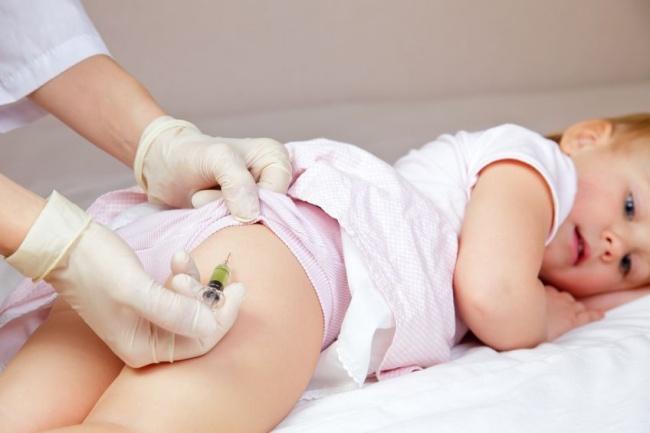
A common situation is when a child, attending a kindergarten, picks up a virus there (after all, no one will forbid children to communicate with each other). Rubella does not manifest itself quickly - it takes from several days to a week. Arriving home, he brings the virus with him. But the mother, who is going to give him a brother or sister, doesn’t even know about it.
And if she does not have stable immunity and has not been vaccinated against rubella before pregnancy, then it is difficult to predict how all this will end for the unborn child. This is how a childhood illness creates completely unchildish problems.
You need to know at what age the rubella vaccine is given. The serum is usually administered in the following order:
- small children from 1 to 1.5 years;
- in preschool age (6-7 years);
- teenagers from 14 to 18 years old;
- adults - up to 25 years of age free of charge, and after - at will at intervals of 10 years.
Since elderly people are not considered a risk group, they are not vaccinated. Although this is not always correct, especially for those who live in the same family with children and grandchildren. Having become infected from them, they themselves can become carriers of the infection.
How and where to give the injection
Vaccination requires compliance with certain rules. In particular, the requirements are:
- injections should only be given by a trained healthcare professional;
- vaccinations are given only in a treatment room with antiseptic conditions;
- injections are performed with disposable syringes with a thin needle;
- the vaccine injection site is pre-disinfected;
- the ampoule with the vaccine is opened right before vaccination;
- the color of the suspension in the ampoule must be standard; if it has changed, the drug cannot be used;
- after the vaccine is administered, the patient must remain under the supervision of health workers for at least half an hour.
It is advisable not to take your child out for a walk for the first 24 hours after vaccination, and for one to two weeks you should make sure that he does not visit crowded places.
As for where the rubella vaccine is given:
- For children up to one year old and after, the vaccine is given only in the thigh - in this place they have thin skin without a fat layer, so nothing will slow down the process of resorption and absorption of the drug. The place of administration of serum to babies is strictly regulated;
- For 6-7 year old children (second dose), the injection is given in the upper part of the arm (just below the shoulder) - this injection site also provides results. Hitting the leg at such an angle is not practiced due to the occurrence of pain that may interfere with movement;
- For adults, the vaccine is injected into the arm or under the shoulder blade - slight discomfort may occur.
Popular: The questionable dangers of flu vaccinations for pregnant women
You should also know that all combination vaccines are injected into the muscle.
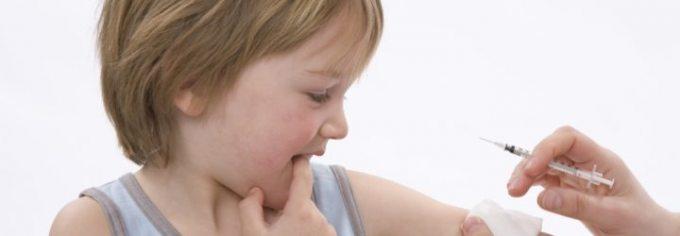
Vaccination schedule
According to WHO recommendations, the following vaccination schedule is used in Russia:
- The first rubella vaccination is given to children up to 12 months (in other developed countries - 9-15 months);
- Children are given the second rubella vaccine at 6-7 years of age. Two vaccinations help build strong immunity against infection before puberty;
- Revaccination is carried out in adolescent children aged 13-15 years.
If a woman is planning a pregnancy, it is recommended to get an additional vaccination against rubella if more than 5 years have passed since the previous vaccination.
Important! The presence of immunity to rubella can be determined by testing the blood for the presence of antibodies to the infectious disease. Their absence indicates the need for re-immunization.
It is important to remember that the severity of the immune response to the entry of the rubella virus into the body is not the same and is determined by individual characteristics. And the duration of protection from a viral disease can vary from 5 to 40 years. Therefore, WHO staff recommend that adults be vaccinated against rubella every 10 years.
Scheme and sequence of vaccinations
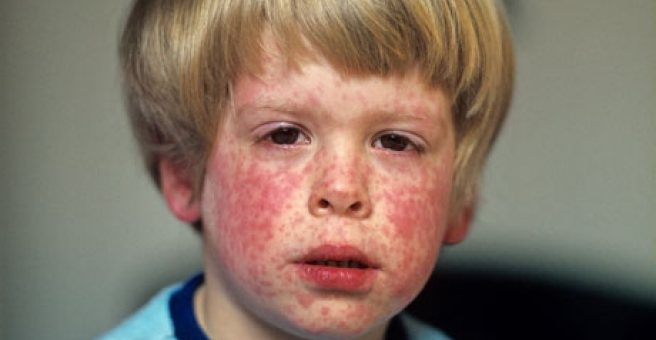
The vaccination schedule against rubella is approved in the regulatory documents of the Russian Federation and complies with WHO standards. It assumes the following sequence:
- the first - for children under one year of age;
- the second - at six or seven years old;
- revaccination – from 13 to 15 years.
The minimum period of protection after vaccination is 5 years. This figure varies and in some patients reaches even 40 years. Only laboratory testing will provide accurate data on the presence of specific antibodies in the blood. According to WHO recommendations, adults need to be vaccinated every ten years.
Possible side effects
In children, vaccination against rubella rarely leads to the development of adverse reactions, if the child is absolutely healthy and the basic rules of vaccination have been followed. In adulthood, vaccination is more difficult to tolerate - the risk of unwanted symptoms increases.
In patients of all age groups, immunization can lead to the following side effects:
- Redness and soreness at the injection site. Possible enlargement of the lymph nodes, which are located in the area adjacent to the injection site (axillary region, neck);
- Weakness, slight increase in temperature, signs of general intoxication;
- Joint pain in older children.
The listed symptoms do not require special therapy. It is quite rare to use painkillers and antipyretic drugs.
If vaccination is carried out without taking into account contraindications, the following conditions may develop:
- The appearance of small red or purple spots - roseola. The rash does not require the use of antiviral drugs and goes away on its own in 3-4 days;
- Allergic reactions: urticaria, angioedema;
- The development of rubella if immunization is given to a patient with severe immunodeficiency.
SIDE EFFECTS
- At the injection site, short-term hyperemia, swelling and induration may sometimes develop, accompanied by pain;
- Skin rash (in the form of small roseola or purple spots of varying sizes);
- A short-term increase in temperature to subfebrile levels; higher temperature in some vaccinated people;
- Lymphadenopathy (enlargement of predominantly occipital and posterior cervical lymph nodes);
- Cough, runny nose, malaise, headache;
- Nausea;
- Arthralgia (in the knee and wrist joints); these reactions occur between 10 and 15 days. after immunization;
- Transient arthritis with and without effusion into the joint cavity;
- Transient polyneuropathy;
- Thrombocytopenic purpura.
All these reactions are characterized by a short-term course and go away without treatment.
Considering the possibility of developing immediate allergic reactions (anaphylactic shock, Quincke's edema, urticaria) in particularly sensitive individuals, vaccinated persons must be provided with medical supervision for 30 minutes. Vaccination sites must be provided with anti-shock therapy.
Do adults need immunization?
Vaccination against rubella is recommended for all women who have reached reproductive age, unless they have previously had a viral infection. This will reduce the risk of developing severe malformations in the fetus. If the state has the financial opportunity, vaccination is recommended for men under 40 years of age. This is necessary to reduce the circulation of the infectious agent in the population.
Important! Rubella vaccinations given to men of reproductive age help protect women and children who come into contact with them from infection.
In Russia, adults are vaccinated against rubella at the age of 22-30 years, when most women want to have children. In addition, in such patients, immunity may weaken after the last immunization in adolescence. Therefore, women need additional protection. The rubella vaccine helps build immunity for the next 10 years.
Important! Subsequently, immunization occurs at 33-39 years of age. Vaccination is not performed because patients in this age range rarely give birth.
Rubella vaccine should be used in the following populations who were not immunized in childhood:
- College students and students;
- Employees of medical institutions;
- Patients who travel frequently;
- Women whose age is between 20-35 years.
The danger of rubella for pregnant women
The infectious disease poses a particular danger to pregnant women. The expectant mother tolerates the infection easily, but in 80% of patients, the introduction of the rubella virus provokes severe developmental abnormalities in the fetus. In this case, the outcome of the disease is determined by the duration of pregnancy.
The greatest danger is posed by infection of a woman for up to 12 weeks, when the formation of vital organs in the fetus occurs. In such cases, defects that are incompatible with life develop. Therefore, pregnancy ends in fetal rejection and miscarriage.
If the infection occurred after the 20th week of pregnancy, then several options for events are possible:
- The birth of a full-fledged child. This is only possible with timely and effective treatment of the mother. However, a newborn may develop congenital rubella syndrome;
- The occurrence of developmental defects. The baby may have heart problems, nervous system pathologies, mental retardation, and damage to the auditory and visual apparatus. Some newborn babies die from complications within 1 month after birth.
Is immunization necessary before pregnancy?
Vaccination against rubella during pregnancy planning is an effective and safe method of protecting the child from the negative effects of viral particles. Vaccination is recommended 1 month before expected conception. The infectious agent is dangerous to the fetus, so WHO recommends against immunization of pregnant women.
Important! If a woman is accidentally vaccinated against rubella in the early stages of pregnancy, doctors do not recommend an abortion. It is enough to regularly monitor the condition of the fetus.
To exclude accidental immunization of pregnant women, it is recommended to identify such patients before vaccination. According to long-term observations, vaccination against rubella during pregnancy does not lead to the development of congenital disorders in the baby.
Drinking alcohol after vaccination
Doctors do not recommend drinking alcohol for three days after vaccination. This is due to the fact that active synthesis of antibodies occurs during this period. Under the influence of alcohol, this process is neutralized, and vaccination is ineffective.

In addition, there is an increased risk of complications occurring after vaccination. The body is already weakened as a result of the penetration of foreign bodies. Alcoholic drinks only make the situation worse.
How to behave before and after vaccination?
No special preparation for immunization is required. However, to prevent the reaction to the rubella vaccine from being intense, doctors recommend adhering to the following recommendations:
- If you are prone to allergies, you should take antihistamines in an age-appropriate dosage 2-3 days before the injection;
- Frequently ill children are advised to take restoratives 7-10 days before vaccination. This will help reduce the risk of developing a secondary infection or exacerbation of chronic pathologies;
- It is not recommended to have a large breakfast before the injection;
- If a child takes vitamin D, treatment should be stopped 3-4 days before vaccination. Therapy is resumed after 5-6 days.
After vaccination, it is not recommended to immediately leave the clinic. Doctors advise staying on the premises of the medical facility for 30 minutes so that staff can provide timely assistance if allergies develop. If there is no fever after vaccination, walks are allowed. However, it is necessary to avoid crowded places for several days to prevent contact with infected people.
Important! If a child attends kindergarten, then after vaccination it is recommended to stay at home for several days.
After immunization, new foods should not be introduced into the diet to avoid the development of an allergic reaction. You need to eat small meals, avoiding overeating and eating fatty foods. You should drink more fluids (jelly, clean water, herbal teas). This will improve the patient’s well-being and will facilitate the rapid evacuation of toxic substances from the body.
Important! Adults will have to abstain from drinking alcohol for 7 days after immunization. After all, alcoholic drinks will interfere with the development of immunity.
METHOD OF APPLICATION AND DOSAGE
Overdose symptoms have not been established.
Immediately before use, the vaccine is diluted with a solvent (water for injection) at the rate of 0.5 ml of solvent per one vaccination dose of the vaccine. To avoid foaming, the vaccine is dissolved by gently shaking the ampoule. The vaccine should completely dissolve within 3 minutes. The dissolved vaccine is a clear liquid from light yellow to pink. The vaccine and solvent in ampoules with damaged integrity, labeling, or changes in their physical properties (color, transparency, etc.) or improperly stored are not suitable for use.
The opening of ampoules and the vaccination procedure are carried out in strict compliance with the rules of asepsis and antiseptics. The ampoules at the incision site are treated with 70° alcohol and broken off, while preventing alcohol from entering the ampoule. To dilute the vaccine, suck out the entire required volume of solvent and transfer it to an ampoule with dry vaccine. After mixing, the vaccine is drawn into a sterile syringe with another needle and used for vaccination.
The vaccine is administered subcutaneously in a dose of 0.5 ml. in the shoulder area after pre-treating the skin at the site of vaccine administration with 70° alcohol.
The dissolved vaccine is used immediately and cannot be stored.
The vaccination performed is registered in the established registration forms, indicating the name of the drug, date of vaccination, dose, manufacturer, batch number, expiration date, reaction to the vaccination.



